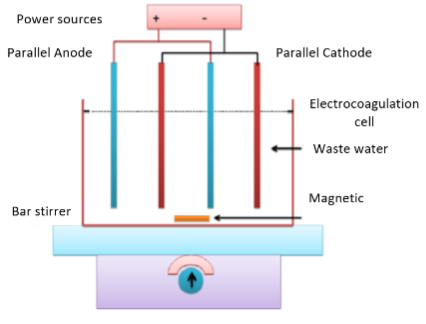Degradation of distillery spent wash using monopolar parallel and monopolar series electrocoagulation process
DOI:
https://doi.org/10.23917/arstech.v2i1.306Keywords:
Distillery spent wash, Electrocoagulation, Novel electrodes, Aluminium foil, Chemical oxygen demandAbstract
In waste treatment and water management issues, electrocoagulation (EC) is the most cost-effective and environmentally friendly option. In the study, EC treatment of distillery spent wash was carried out using new electrodes packed with aluminium foil scraps. These metal scraps were packed in a mesh to function as anode and cathode electrodes. Electrochemical treatment was carried out for 150 minutes, and samples were analysed regularly to determine the colour and chemical oxygen demand (COD). The impact of operating parameters such as pH, applied current, electrolysis time, agitation speed, and electrode distance on colour and COD removal was investigated. The EC processes were carried out in monopolar parallel (MP-P) and monopolar series (MP-S). The MP-S connection measured the potential difference between the amplified pair of electrodes, whereas the output signals in the MP-P connection were formed by several input electrodes, resulting in a high removal rate. The results indicated that the MP-P relationships enhance the COD removal rate by 4.16 to 8.06 %. An optimum chemical oxygen demand degradation is 77.29 % at pH 3, and decolourisation is 76.55 % at pH 8.3. TDS is reduced to a maximum of 58.32 %, while sulfate and chloride are reduced to 64.72 and 20.44 %, respectively.
Downloads
References
M.P. Wagh, P.D. Nemade, and S.R. Dhasal, "Colour and COD removal of distillery spent wash by using electrocoagulation", International Journal of Engineering Research and General Science, Vol. 3, No. 3, pp.1159–1173, 2015
J. Shadmehr, S.M. Mirsoleimani-azizi, and S. Zeinali, "Electrocoagulation process for propiconazole elimination from wastewater: experimental design for correlative modeling and optimisation", International Journal of Environmental Science and Technology, Vol. 16, pp. 5409–5420, 2019. https://doi.org/10.1007/s13762-018-1891-8
M.P. Wagh, P.D. Nemade, and P. Jadhav, "Continuous electrocoagulation process for the distillery spent wash using Al electrodes", Proceedings of the 2nd International Conference on Advanced Technologies for Societal Applications, Vol. 2, pp. 41-49, 2019. https://doi.org/10.1007/978-3-030-16962-6_5
O. Sahu, B. Mazumdar, and P.K. Chaudhari, "Electrochemical treatment of sugar industry wastewater: process optimisation by response surface methodology", International Journal of Environmental Science and Technology, Vol.16, pp. 1527–1540, 2019. https://doi.org/10.1007/s13762-018-1765-0
M.P. Wagh and P.D. Nemade, "Treatment of distillery spent wash by using chemical coagulation (CC) and electrocoagulation (EC)", American Journal of Environmental Protection, Vol. 3, pp.159–163, 2015. https://doi.org/10.12691/env-3-5-1
M.P. Wagh and P.D. Nemade, "An influence of experimental parameters in the treatment of anaerobically treated distillery spent wash by using ozone assisted electrocoagulation", Desalination and Water Treatment, Vol. 83, pp. 7–15, 2017. https://doi.org/10.5004/dwt.2017.21041
M.P. Wagh, "Ozone assisted electrocoagulation and fungal treatment for distillery spent wash", Ph.D. Thesis, Pune University, Pune, India, 2019.
M.P. Wagh and P. Nemade, "Remediation and decolourisation of distillery spent wash by using advanced oxidation processes – A Review", Indian Journal of Environtment Protection, Vol. 39, No. 7, pp. 651-658, 2019.
Z.B. Gönder, G. Balc?o?lu, Y. Kaya and I. Vergili, "Treatment of carwash wastewater by electrocoagulation using Ti electrode: optimisation of the operating parameters ', International Journal of Environmental Science and Technology, Vol.16, pp. 8041–8052, 2019, https://doi.org/10.1007/s13762-019-02413-4
M.P. Wagh and P.D. Nemade, "Treatment processes and technologies for decolourisation and COD removal of distillery spent wash: a review", International Journal of Innovative Research in Advanced Engineering, Vol. 2, No. 7, pp. 30–40, 2015
M.P. Wagh and P.D. Nemade, "Biodegradation of anaerobically treated distillery spent wash by Aspergillus species from a distillery effluent contaminated site", Desalination and Water Treatment, Vol. 104, pp. 234–240, 2018. https://doi.org/10.5004/dwt.2018.21838
M.P. Wagh, N.M. Mulik, and P.D. Nemade, "Electro-Coagulation [EC] process to treat basic dye", International Journal of Development Research, Vol. 6, No. 5, pp. 7858-7862, 2016.
K. Ravindra, M.P. Wagh, and S.B. Thakare, "Post treatment to biomethanated distillery spent wash by using Chitosan Powder", International Journal for Science and Advance Research in Technology, Vol. 3, No. 6, pp. 866-869, 2017.
K. Ravindra, M.P. Wagh, and S.B. Thakare. "Application of Chitosan powder to enhance the properties of distillery spent wash", International Journal of Engineering Research and General Science, Vol. 5, No. 3, pp. 249-257, 2017.
M.P. Wagh, P.D. Nemade, and A. Sengupta, "Augmentation with ozone-assisted electrochemical degradation of distillery spent wash for the removal of color and chemical oxygen demand", International Journal of Environmental Science and Technology, Vol. 18, pp. 619-630, 2021. https://doi.org/10.1007/s13762-020-02837-3
APHA (American Publication Health Association), "Standard methods for the examination of water and wastewater", The 20th edition, American Public Health Association Inc. New York, 2008.
M.P. Wagh, P.D. Nemade, and A. Biradar. "Assessment of Coagulation process for the distillery spent wash using Alum polyelectrolyte and Fenton", Indian Journal of Environmental Protection, Vol. 40, No. 7, pp. 747-751, 2020.
E.S. Shahida, S.H. Afzali, N. Talebbeydokhti, and M. Rastegar, "Dye removal and disinfection in one reactor by non-pulsed high voltage current using iron, aluminum and copper electrodes", Desalination and Water Treatment, Vol. 178, pp. 337–346, 2019.
M.P. Wagh, P.D. Nemade, U.P. Naik, and A. Sengupta, "Enhancing color and chemical oxygen demand degradation in distillery spent wash by electrocoagulation and ozone assisted electrocoagulation", Desalination and Water Treatment, Vol. 197, pp. 213-223, 2020. https://doi.org/ 10.5004/dwt.2020.25997
M.P. Wagh and P.D. Nemade, "Biogas generation from distillery spent wash by using an opur western biotechnology process: a case study", Desalination and Water Treatment, Vol. 118, pp. 241-248, 2018. https://doi.org/10.5004/dwt.2018.22404
R. Danial, L.C. Abdullah, and S. Sobri, "Potential of copper electrodes in electrocoagulation process for glyphosate herbicide removal", MATEC Web of Conferences., Vol. 103, 06019, 2017.
A.Y. Gören, M. Kobya, E. S?k, E. Demirbas, and M.S. Oncel, "Combined influence of some cations on arsenic removal by an air-injection EC reactor using aluminum ball electrodes", Desalination and Water Treatment, Vol. 178, pp. 240–253, 2020. https://doi.org/10.5004/dwt.2020.24957

Downloads
Published
How to Cite
Issue
Section
Categories
License
Copyright (c) 2021 Sukanya Pujari, Manoj Wagh, Shila Dare

This work is licensed under a Creative Commons Attribution 4.0 International License.










